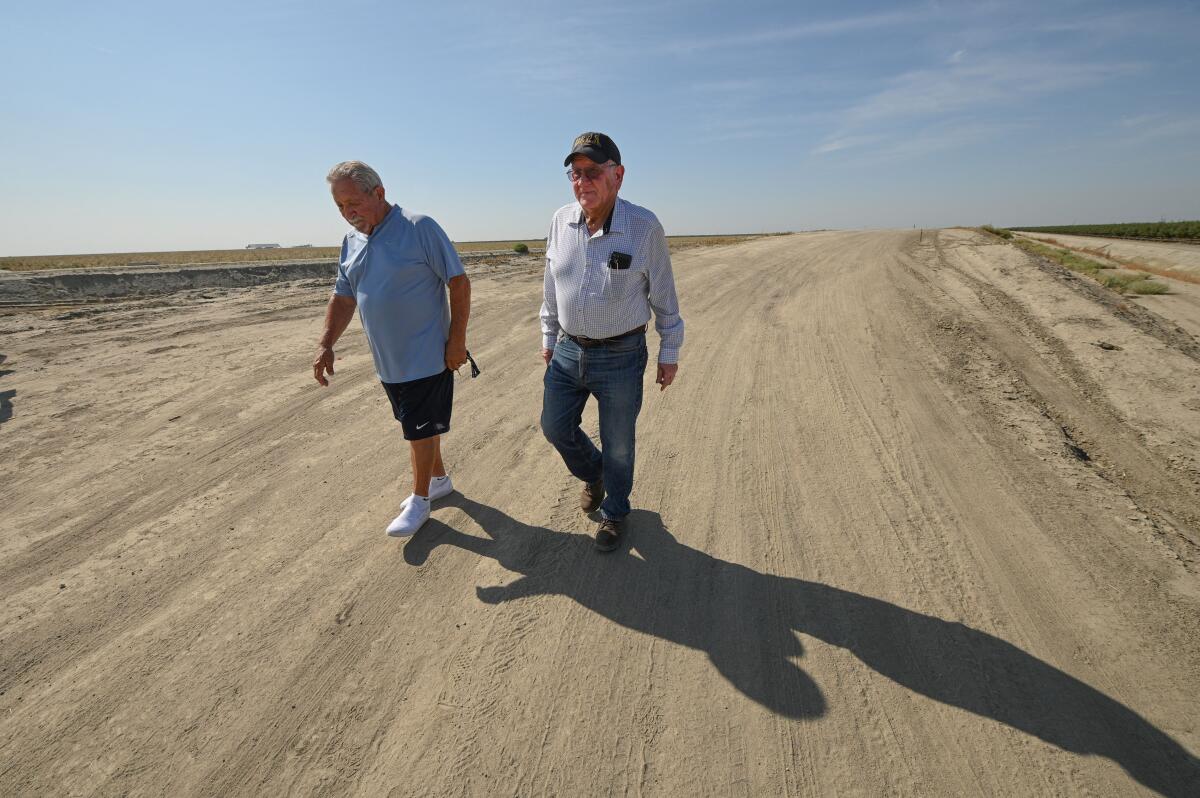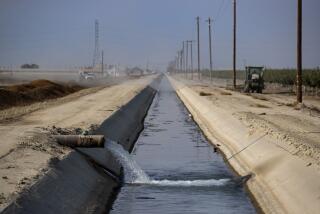State tells San Joaquin Valley agencies that groundwater plans are flawed

- Share via
California water officials have alerted local groundwater agencies in farming areas across the San Joaquin Valley that their plans for bringing aquifers into balance don’t adequately address how continuing declines in water levels could cause many more wells to run dry.
The state Department of Water Resources notified agencies in six areas of the San Joaquin Valley this week that their groundwater sustainability plans are incomplete and have deficiencies that need to be corrected. While the specifics of the flaws will be outlined when assessments are released in January, the department said many of the submitted plans lacked details about addressing how declining groundwater levels in the coming years will likely continue to cause well failures, sinking ground and worsening effects on drinking water quality.
The local agencies were required to prepare plans for combating chronic over-pumping under California’s landmark 2014 Sustainable Groundwater Management Act, or SGMA. The state has designated 21 groundwater basins as being in a state of “critical overdraft,” and these areas — many of them in the Central Valley — have until 2040 to achieve their sustainability goals.
The law requires that while local water agencies are working toward these goals, they must avoid undesirable results, such as “significant and unreasonable” depletion of aquifers, degraded water quality or land subsidence.
“The standard in the law is ‘significant and unreasonable’ effects,” said Paul Gosselin, deputy director of DWR’s sustainable groundwater management office. “I think it’s kind of hard to justify wells going dry and not being significant and unreasonable. I think if you have your water supply shut off, that’s pretty significant.”
The state’s analysis of a number of the plans found projected water level declines during the next 20 years “would result in a number of community or domestic wells being dewatered,” Gosselin said.
If local water authorities intend to allow some shallow wells to be left high and dry, Gosselin said, they would need to provide justification, which he said would be a difficult task. Alternatively, some plans have included projects to deal with well failures, such as deepening wells or connecting homes that run out to another water supplier.
The state has received reports of 969 dry household wells in California this year, a tenfold increase from last year. Many of the wells have dried up in farming areas of the San Joaquin Valley, where farms have turned to pumping more from wells as water supplies from rivers have dwindled during one of the most severe droughts on record.
SGMA has faced criticism from advocates who say the long implementation timeline allows local agencies to delay steps toward limiting pumping.
Under the law, agencies may take a “glide path” in which groundwater levels continue to decline before gradually stabilizing, Gosselin said. However, if water drops below historic lows in some areas, he said, that may exacerbate other water quality issues.
In rural communities in the San Joaquin Valley, many continue to rely on wells that pump water tainted with hazardous nitrates from agricultural fertilizers and natural contaminants like arsenic. When water levels drop, what remains in the aquifer may contain higher levels of contaminants.
“Some of the plans did not fully account for all the water quality issues in the basin,” Gosselin said. If water tables are allowed to decline to historic lows, he said, “then we’d want them to take a much closer look to track and determine how that may affect some of those plumes or water quality issues.”
In reviewing the plans, the department’s officials are also considering whether they sufficiently limit declines to address problems of sinking ground. The land can subside when water is drained from aquifers, leaving spaces that collapse.
According to a recent state report, land in portions of the southern San Joaquin Valley has been sinking as rapidly as 1.5 feet per year. The collapsing ground is affecting infrastructure, reducing the water-carrying capacity of the California Aqueduct, the Delta-Mendota Canal and other canals, which will require costly fixes.
“Some of the plans, as we reviewed them, indicated that there may be continued subsidence into the next 20 years,” Gosselin said. “The statute requires that subsidence either be minimized or eliminated. So we pointed that out to them.”
The agencies were required to submit their plans by 2020, and the state had two years to review them. Once the final state assessments are done next month, the local agencies will have 180 days to resolve the flaws.
The law put newly created local agencies in charge of managing groundwater but gave state regulators a backup role. If some of the agencies fail to address state officials’ concerns, their plans could be declared inadequate. And that would start a process in which regulators at the State Water Resources Control Board would step in.
The Department of Water Resources sent letters to water managers who prepared 28 groundwater sustainability plans in six areas across the farming areas of the San Joaquin Valley, including the Delta-Mendota, Kaweah, Kern County, Kings, Tulare Lake and Tule sub-basins. There are 61 local groundwater agencies in these areas.
Justine Massey, policy manager with the nonprofit Community Water Center, said the “heads-up letters” from the state are a step in the right direction and that domestic well owners and small communities shouldn’t have to shoulder the consequences of unsustainable water management.
“Domestic water users are specifically called out in the SGMA statute to be considered in creating the plans, and that’s not what we’ve seen so far at a local level,” Massey said. “Pretty much across the board in those basins, they were not considering domestic wells appropriately and were going to allow the vast majority of them to go dry if the minimum thresholds were reached, which is like the lowest allowable level before it’s considered an undesirable result.”
When wells have gone dry, many families have struggled to find solutions, often installing tanks and relying on trucks to deliver drinking water. Areas that have been hit hard both during the 2012-16 drought and again this year have included predominantly Latino communities where many are farmworkers.
Meanwhile, large farming operations producing nuts, fruits and other crops have continued pumping without limits.
“We can’t have wells go dry for 20 years anticipating that at the very end some pumping restrictions will come into play to balance out the basin,” Massey said. “SGMA is supposed to gradually get us to sustainability, but along the way they need to make progress. And they can’t just sacrifice drinking water users in order to maximize profits from pumping.”
Massey and other advocates say the rights of domestic well owners and rural communities must be respected — especially since the state in 2012 recognized water access for all as a human right.
In recent months, state officials have been weighing in on problems in the local plans.
Natalie Stork, chief of the groundwater program for the state water board, wrote to the state Department of Water Resources in August to raise concerns about the plan for the Tulare Lake sub-basin. Stork said the plan “allows for continued groundwater overdraft without any plan to mitigate potential impacts to domestic wells or drinking water systems.”
In November, DWR notified agencies in four other areas of the San Joaquin Valley that their plans had flaws and would require changes to address the effects of chronic groundwater declines and the risks of more wells going dry.
In a study last year, researchers found that thousands of household wells are vulnerable to going dry in the Central Valley.
In another report for the Pacific Institute, researcher Darcy Bostic examined the vulnerability of wells that supply public drinking water in the San Joaquin Valley. Bostic analyzed 1,200 wells and found that 42% are likely to go partially or fully dry under the plans local agencies submitted to the state.
When limits on pumping eventually kick in under the law, some farmlands are expected to be left dry and fallow. Researchers with the Public Policy Institute of California have estimated that addressing the groundwater deficit in the San Joaquin Valley could require taking at least half a million acres of farmland out of production, and possibly much more.
Researchers with the institute have also warned that some agencies are probably underestimating overdraft, a flaw that takes on even greater importance as climate change intensifies droughts in the West.
“We have got to speed up the implementation of the Sustainable Groundwater Management Act,” said Jeffrey Mount, a senior fellow at the institute’s Water Policy Center. Mount said with the law allowing two decades, local agencies are planning to allow unsustainable pumping for years until they begin to significantly reduce pumping.
“And that means some of the really bad consequences,” Mount said, including the drying of more wells and more land subsidence.
“This is a real, difficult, painful set of decisions that are going to have to be made as to how to come into balance,” Mount said. But he said it’s crucial as the heating of the planet puts growing strains on California’s water supplies.
“Groundwater is our best hedge against this warming and drying climate,” he said.
By pursuing projects to capture floodwaters and use it to recharge aquifers, Mount said, the state can bolster its water supplies. But safeguarding groundwater will also require moving faster to manage the underground reserves, he said, “to get these basins to sustainability much more quickly.”







